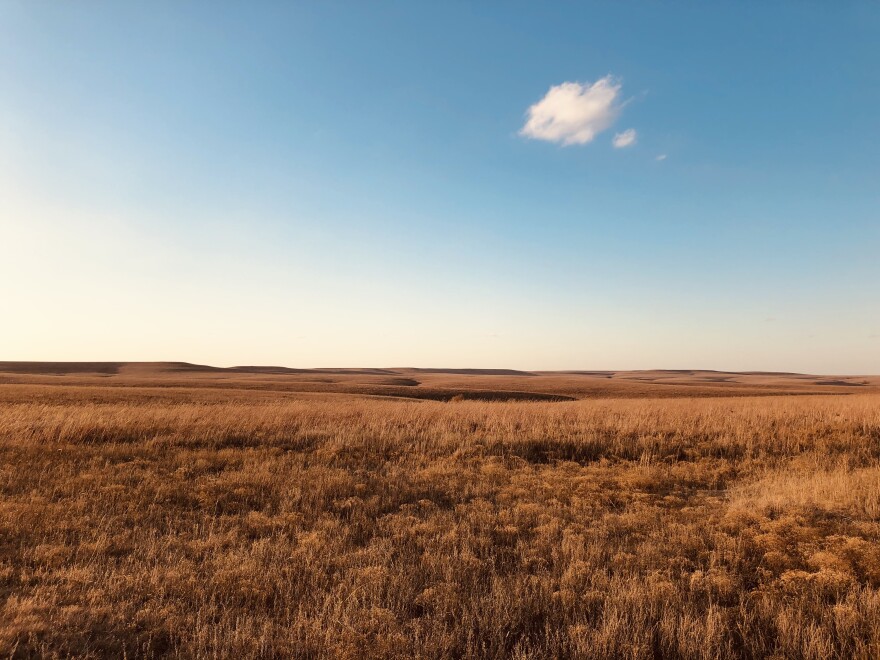This story was first published in KCUR's Adventure! newsletter. You can sign up to receive stories like this in your inbox every Tuesday.
About seven generations ago, prairie swept across 40% of North America, known only to its Native American inhabitants, the wildlife that roamed the plains, and white traders. Over the last 10,000 years, the area had developed into a unique, biodiverse environment shaped by ice, wind and fire.
Within a generation of white settlement, most of the prairie was converted to agriculture. Now, only about 1% of that native prairie remains, making it one of the world’s most endangered ecosystems.
Around Kansas City, the prairie gives its name to villages, art installations and shopping centers, yet none of those entities provide the sensibilities of the windswept open range.
It’s an environment that seems broad and plain at first look, but further exploration reveals complexity in a landscape that both restores air quality and cleanses the soul.
Here are a few pieces of local native prairie you can still explore and appreciate up close.Tallgrass Prairie National Preserve

Protected by the unplowable Flint Hills, Tallgrass Prairie National Preserve is one of the last and largest remaining stretches of tallgrass prairie. It's located about two hours southwest of Kansas City, just close enough for a day trip.
Operated in partnership between the National Park Service and The Nature Conservancy, the site is open 24 hours a day (except during prescribed fire burns), with 40 miles of hiking trails and rolling hills of unparalleled scenery and unimpeded night sky viewing.
It’s home to birds, deer, coyote, a herd of bison and a horse named Badger.
There's also a restored historic farmhouse, a barn — where Badger lives and helps with history presentations — and a schoolhouse built in 1882. You can also take a virtual tour of the historic buildings at Spring Hill Farm.
You can learn more about planning for your visit to Tallgrass Prairie National Preserve from the Nature Conservancy.
Kaw Mission State Historic Site, located nearby in Council Grove, is currently undergoing renovation and reinterpretation to better serve its visitors. Once open, visitors can learn more about the history of the prairie and the people who lived in the area prior to white settlement.Konza Prairie Biological Station

The Konza Prairie Biological Station, just south of Manhattan, Kansas, is also a native tallgrass prairie preserve, operated under a partnership between the Nature Conservancy and Kansas State University. It is “dedicated to a three-fold mission of long-term ecological research, education, and prairie conservation.”
The research station is named to honor one of the peoples known to have inhabited the land: the Kanza, or Kaw, from whom Kansas got its name. According to “History and Use of Konza Prairie Research Natural Area,” by Lloyd Hulbert, there were over 80 documented name spellings for the Kanza. “Konza” was chosen because it was different enough that people wouldn’t think it was just a misspelling of the state name.
There are hiking trails in the preserve open to the public, available dusk to dawn, weather permitting. Most of the research facility is off limits, however, with vehicles, pets, and camping prohibited.
The Friends of Konza Prairie is a separate non-profit organization that supports Konza Prairie education programs, with special events throughout the year.
Each spring portions of the prairie are intentionally burned to support the natural cycle. Volunteers can help with the prescribed burns, though training is required. Learn more about the process with this orientation video.Around Kansas City

From the city concrete to sterile suburban lawns, it may seem like the prairie wilderness is far afield; but remnants of prairie pocket the region, close enough for a restorative hike through our environmental history.
In Missouri, Jerry Smith Park in south Kansas City has the only piece of remaining prairie within city limits. You can see all the public prairies in Missouri on this interactive map.
In Olathe, Kansas, The Prairie Center provides relatively easy access to the landscape, with both gravel and trimmed paths through the grasses of remnant and reclaimed prairie. A creek and many ponds create varied environments to explore within the 300-acre park. Cedar Niles Park, which opened in early 2022, is adjacent to the Prairie Center and also includes restored prairie land.
A handful of local parks include sections devoted to prairie restorations, including Shawnee Mission Park, Powell Gardens and the Overland Park Arboretum. Grasslands Heritage Foundation lists many of these regional prairie sites on its website.Conservation and restoration of Native landscapes

Since only a small portion of native prairie remains, wildlife enthusiasts engage in both preservation and restoration.
To bolster the 1-4% of remaining prairie, many conservationists turn their attention to reclaiming prairie lands by removing invasive species and replanting native seed for grasses, trees and shrubs that help the land prevent erosion and resist drought conditions.
Kansas City WildLands aims to restore and protect the region’s public natural landscapes, in part by connecting resource professionals with conservation-minded citizens to achieve that goal. There are lots of ways to help.
But restoration isn’t just about replanting regional flora. Plants and animals maintain a complex relationship, pollinating flowers, spreading seeds, eating the grasses and — especially in the case of bison — turning the soil and adding nutrients back in.
Missouri Prairie Foundation promotes prairie management, education, research and advocacy for the protection of native environments, with 3,200 acres of prairie in 23 locations around the state.Plant a pocket prairie

“To make a prairie it takes a clover and one bee," Emily Dickinson wrote.
While it might take more than reverie to restore these native lands, Dickinson wasn’t too far off. Adding even a few native plants to a yard or green space can enhance local biodiversity.
In urban or suburban environments, pocket prairies (or micro prairies) in parking strips or traffic medians help with storm runoff, air quality, and ease of maintenance, and can work well for home and school settings, too.
It’s not just a matter of retiring the lawnmower, though. Evaluate your space. Along with reintroducing native species, you may also need to remove non-native species and eradicate invasive ones.
Organizations like Grow Native from the Missouri Prairie Foundation, or the Kansas Native Plant Society can help identify the type of native plants that will flourish in different settings.







